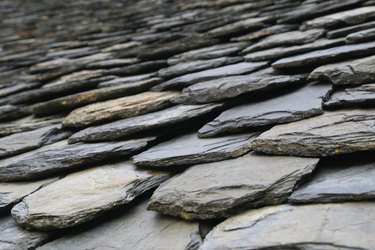
Slate tiles – both old, repurposed roofing tiles or slate designed for interior tile projects – may be painted with several different types of paint. No matter which type of paint you use, the slate must be clean and free of debris in order for the paint to adhere well.
A Clean Slate
Video of the Day
Whether covering the entire slate tile with color or simply writing a word or two on it, the slate must be completely clean, otherwise dirt and debris may stick in the paint, marring your work. If repurposing old tiles, brush off loose dirt and moss with a nylon-bristled scrub brush, or use your hand while wearing a work glove. Avoid using wire brushes, as they can scratch the delicate slate. Once all loose debris has been removed, wash the slate with dish soap mixed into warm water. Use a sponge or nylon scrub brush to clean the tile, and then rinse the slate with a hose or wipe it down with a damp sponge. Allow the slate to dry completely before painting. To ensure both sides dry, prop the slate up vertically against another object where it won't be bothered, or rest it upon a wire rack outdoors on a sunny, dry day.
Video of the Day
Brush-On Painting Process
Most opaque paints adhere well to slate without any type of primer or additive because the tile is a porous natural stone. Acrylic craft paint and latex paints are the most user friendly when it comes to slate – they can be cleaned up with water and do not emit strong fumes. If painting an entire side of the slate, brush on a base coat with the desired background color, then paint on a second coat, if necessary, once the first dries. If your design idea does not require a background color, sketch the design in pencil or chalk, then trace the outline with a brush dipped in latex or acrylic paint. Fill in the area between the lines with your desired paint color. To layer colors, wait for the first shade to dry and then apply the next, or work while the first shade is still wet to blend colors, creating shadows or ombre-style designs. Use painter's tape to create designs such as stripes or borders around the slate tile, smoothing down the tape firmly on the irregular slate surface to ensure the paint doesn't bleed beneath the tape.
Spray Paint Simplicity
Any general spray paint that adheres to wood or stone also adheres to plain slate tile. Set the slate atop newspaper or cardboard outdoors on a calm day or in a well-ventilated area. Spray the entire slate by shaking the spray can for a minute or two, then holding it 12 inches or so from the slate. Begin each spray burst slightly before the edge of the slate, then end it after the slate, overlapping each application of paint row after row. Create funky visual effects by spraying through materials such as lace doilies or mesh produce bags, or use painter's tape to mask off areas for stripes or sections you wish to leave plain. Spray paint may require more than one layer to achieve an opaque finish.
Sealing Your Work
Sealing the slate isn't entirely necessary if you plan to keep the tile indoors, but it will protect it. A clear acrylic sealer, a spray-on polyurethane or even decoupage medium, may be used to seal your work for indoor decor purposes. Any one of the three may make the piece look a bit wet or shiny afterwards. Apply brush-on sealers with a foam brush or nylon brush. If painting slate designed for outdoors, use a waterproof stone sealer designed for natural-stone flooring.
- Sunshine Crafts Projects Blog: Slate Coasters Pointsettia
- Ben Franklin Crafts and Frame Shop: Painting: General Prep Instruction for Various Surfaces
- "Decorative Painting for the First Time;" Plaid
- Simply Designing: Merry Christmas Slate Decor
- Bane Clene: Slate Tile Floor Care
- Wall to Wall Stencils: Welcome Slate